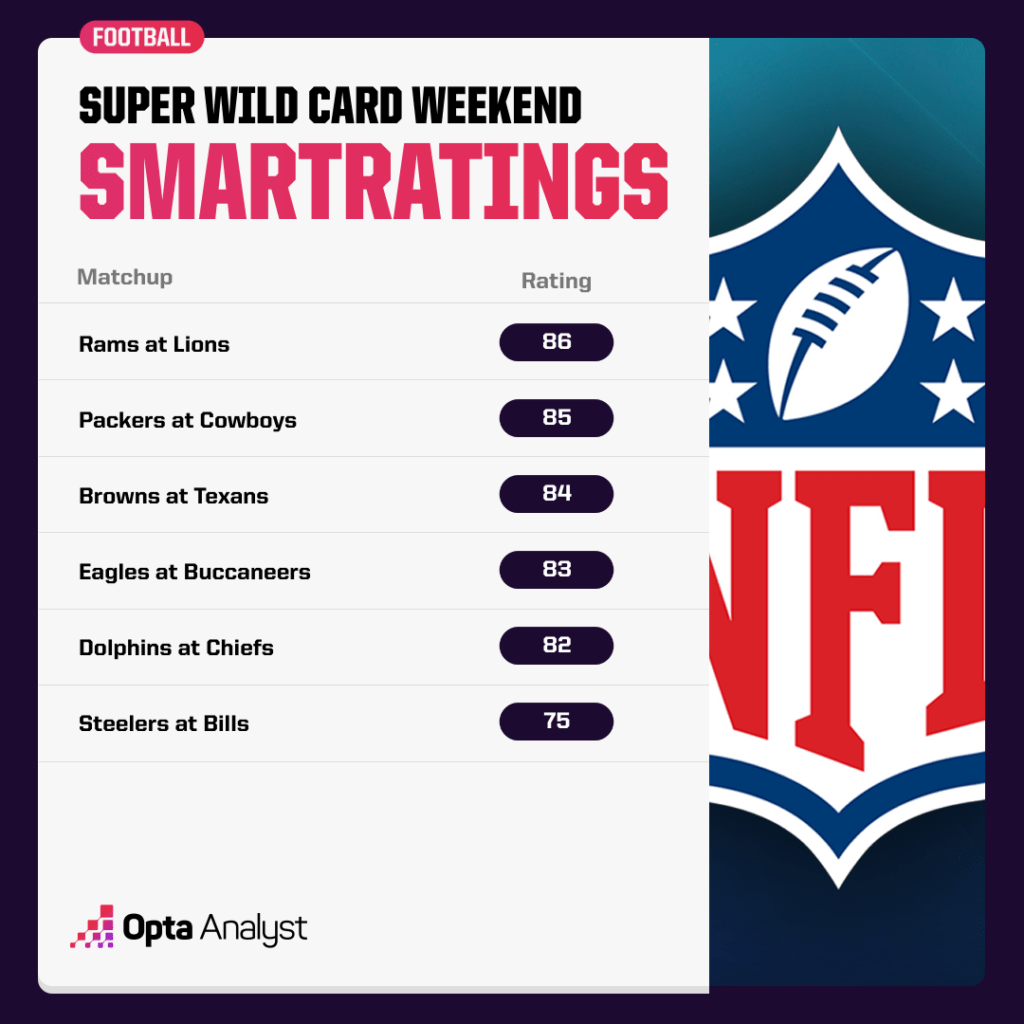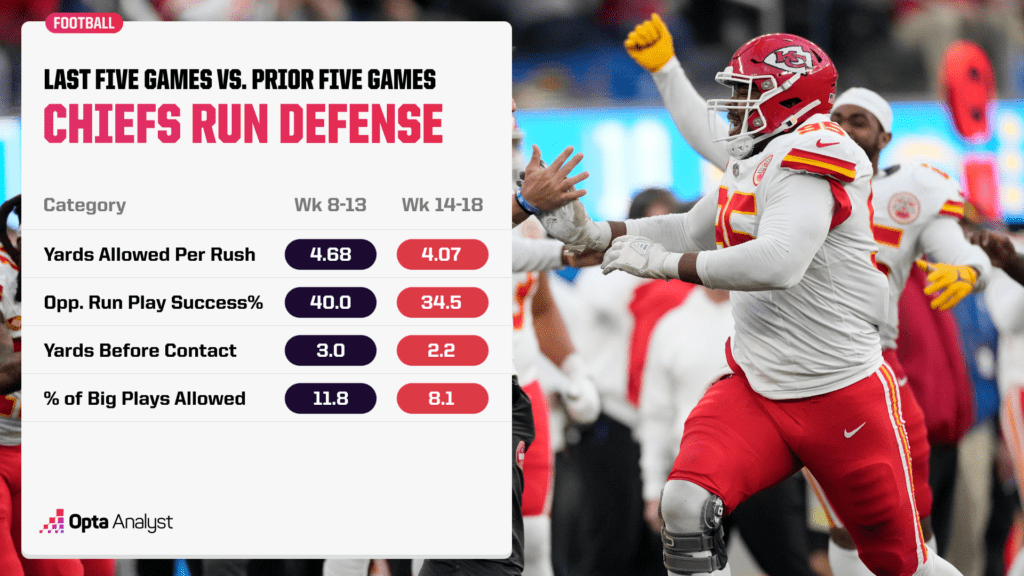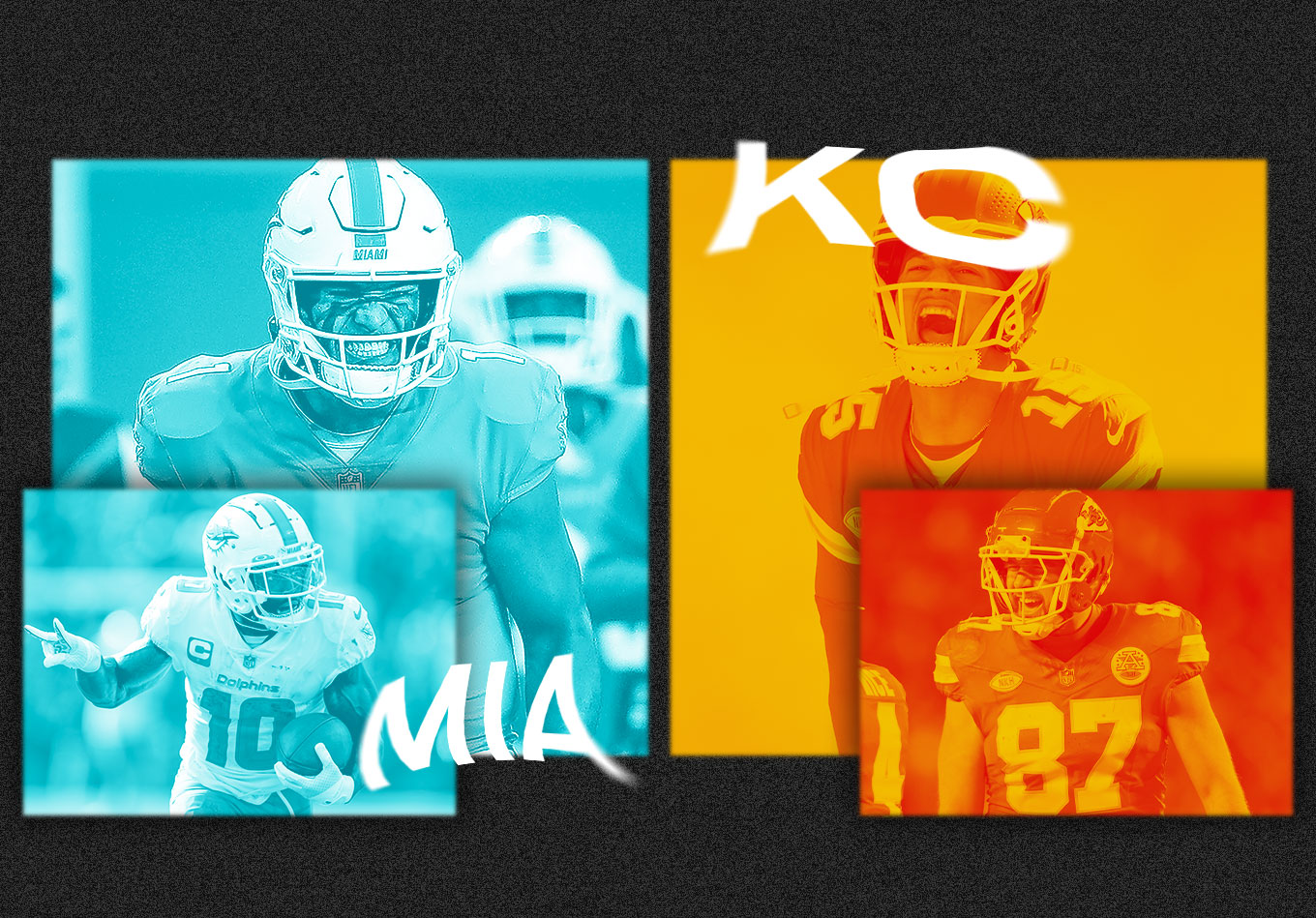Momentum won’t be on the Miami Dolphins’ side when they visit Arrowhead Stadium this Saturday night to take on the defending Super Bowl champion Kansas City Chiefs in an AFC wild-card game.
History won’t be either.
Much has been made of the Dolphins’ 1-5 record this season against teams that finished above .500, a hurdle that ultimately cost Mike McDaniel’s team an AFC East title.
That lack of success still pales in comparison, however, to two other very negative trends Miami must break in order to extend what’s been an up-and-down season.
Quarterback Tua Tagovailoa was a toddler the last time the Dolphins won an NFL playoff game of any kind back in 2000. And the last time Miami won an outdoor road game in the postseason?
How about the 1972 AFC championship game in Pittsburgh’s Three Rivers Stadium?
LONGEST ACTIVE STREAKS OF CONSECUTIVE SEASONS WITHOUT A PLAYOFF WIN
- 1. Detroit Lions (31 years)
- 2. Miami Dolphins (22)
- 3. Las Vegas Raiders (21)
- 4. Washington Commanders (18)
- T-5. Chicago Bears (13)
- T-5. New York Jets (13)
After closing out the regular season with losses both humiliating (a 56-19 shellacking by the Baltimore Ravens on New Year’s Eve) and heartbreaking (a 21-14 defeat to the Buffalo Bills last week), the Dolphins won’t be staying in cozy Miami during Super Wild Card Weekend with a division crown they would have held had they won either of those games.
Instead, they’ll be trying to break a spell of 11 consecutive defeats in outdoor road playoff games with an unwelcoming trip to frigid GEHA Field (on NBC/Peacock), where temperatures are forecasted to be below zero at kickoff along with strong winds capable of slowing down a team built on speed.
Miami has lost 10 straight times when playing in temperatures below 40 degrees, a streak that dates back to the 2016 playoffs. And the Hawaiian-born Tagovailoa has struggled in colder conditions, having completed just 55.6% of his throws with four interceptions and a 69.5 passer rating while under center for three of those defeats.
The Dolphins did give the Bills a real run for their money in chilly weather during last season’s wild-card round, however, before eventually losing a 34-31 thriller. And that came with current No. 3 quarterback Skylar Thompson filling in for an injured Tagovailoa, so there’s certainly hope that Miami can finally put an end to all those ignominious streaks if able to recapture the form that made it one of the AFC’s most serious contenders earlier this season.
Another potential confidence boost may come in the fact that the Chiefs haven’t been the juggernaut they undoubtedly were during a dominant four-year run leading into this season, a stretch in which they won two Super Bowls, lost another and reached the AFC title game each time.
The AFC West champions have also had their issues against upper-echelon teams, having gone 1-4 versus this season’s playoff field. The one win? It came against the Dolphins when these teams squared off in Germany in early November.
Kansas City averaged a ho-hum 21.8 points per game over the course of its 11-6 run, which isn’t just the lowest mark of the Patrick Mahomes era, but the lowest in any of Andy Reid’s 11 seasons as head coach. The Chiefs have been held under 20 points eight times this season, something that occurred just once during their 2022 title march.
The defense has shown up all year long, though, and the pedigree is still there, which why the wagering public holds the Chiefs in a bit higher esteem, with the Dolphins presently a 4.5-point underdog. And as we’ll explain below, the weather won’t be the only challenge Miami will have to conquer to knock the Chiefs off their throne.
Believe it or not, this matchup ranks fifth of the six wild-card games in SmartRatings, which is an AI-based platform that provides excitement ratings for sporting events, teams and players. The excitement scale translates to the following general sub-ranges: 0-39 (Dull Game), 40-64 (OK Game), 65-84 (Good Game), 85-100 (Great Game).
So it still falls just short of the “great game” category with its 82 rating.

Miami Key: Find a Pass Rush
The bitter and blustery weather likely won’t alter the Chiefs’ game plan a great deal, or at least not as much as it could Miami’s. Kansas City throws the football a lot, but it doesn’t take a large amount of the downfield shots that would theoretically most be affected by tricky winds.
With Mahomes struggling on his deep attempts this season – he’s connected on a meager 29.3% of throws of 21 or more air yards – and the Chiefs lacking a dependable field-stretching receiver (someone along the lines of Tyreek … um, never mind), the offense has concentrated on getting its playmakers in space and peppering them with high-percentage, short-range passes to methodically move the ball.
That strategy hasn’t resulted in a wealth of chunk plays, but it has been an effective enough use of the talent on hand. Kansas City receivers have averaged a league-low 3.9 yards at the point of the catch, but their average of 6.5 yards after the catch is second only to the NFC-best San Francisco 49ers for tops in the NFL.
It helps to have a two-time league MVP at the controls in Mahomes, whose 84.7 well-thrown percentage is the third highest among quarterbacks with at least 170 adjusted attempts this season. And if there’s one thing that hasn’t changed about the 2023 Chiefs, it’s that how their franchise face performs is usually the single biggest factor in determining a game’s outcome.
Mahomes has completed 66.7% of his attempts or better with a passer rating of 90 or above nine times this season – all Kansas City wins. When he’s gone below those thresholds, the Chiefs are 1-6.
And when Mahomes gets a clean pocket, he’s hit on almost 77% of his adjusted attempts – a rate that would be even higher if the Chiefs didn’t have the most dropped passes in the league. He’s been far more mortal when under duress, though, as that completion rate drops to 52.9% when under pressure and he’s often forced the ball when hurried, having targeted an open receiver just 64.7% of the time in those situations.
Harassing the quarterback hasn’t been a problem for Miami, which ranks second overall in pressure rate at 41.7%. It may be now, however, considering a recent rash of injuries that has left the Dolphins scrambling to find competent edge rushers.
After losing Jaelan Phillips to an Achilles tear in Week 12 and then Bradley Chubb and his 11.0 sacks to a torn ACL in the Baltimore debacle, the Dolphins learned that unheralded understudy Andrew Van Ginkel will miss the entire postseason after hurting his foot against the Bills last week. Van Ginkel had actually been the most impactful of the trio, as his pressure (21.5) and adjusted sack (5.6) rates were both in the top 10 among edge players with 150 or more pass-rush attempts.
Now the Dolphins will try to get by in a do-or-die game with some combo of Melvin Ingram and the just-signed pairing of former Chief Justin Houston and Bruce Irvin, all of whom are at least 34 years old and certainly past the prime of their careers.
The cupboard still isn’t bare, however, as Miami still has two healthy and very good tackles in Christian Wilkins and Zach Sieler, who have combined for 19.0 sacks with pressure and adjusted sack rates considerably above league average for interior linemen. And Ingram showed he may have some juice left by registering four pressures and 1.5 sacks when pressed into duty against Buffalo.
Kansas City’s offensive line is at its strongest inside, with center Creed Humphrey and guards Joe Thuney and Trey Smith all yielding pressures at rates lower than league norms for their positions. It’s therefore imperative for the Dolphins to get some contribution from their aging group of outside rushers to help prevent a repeat of what occurred in the Chiefs’ 21-14 win over Miami in Frankfurt.
The Dolphins’ pressure rate that day came in at 34.2%, not enough to deter Mahomes from picking the secondary apart in the first half by throwing for 147 yards and two touchdowns on 14-of-19 passing as the Chiefs built a 21-0 lead. And that success came even with Miami neutralizing star tight end Travis Kelce to a season-low 14 yards on three catches, and despite impressive rookie receiver Rashee Rice being targeted only twice.
Rice will surely have more of a say in this game, as he emerged as one of the league’s more productive receivers down the stretch by averaging better than seven catches and 86 yards over his last six NFL games. The second-round pick has the third-highest open rate among wide receivers with 50 or more targets at 85.3%, and he’s been among the best at churning out yards after the catch.
AVERAGE YARDS AFTER CATCH LEADERS AMONG WRs (MIN. 50 TARGETS)
- Deebo Samuel, San Francisco 49ers (8.7)
- Rashee Rice, Kansas City Chiefs (8.5)
- Nico Collins, Houston Texans (7.0)
- DeMario Douglas, New England Patriots (7.0)
- George Pickens, Pittsburgh Steelers (6.4)
Kansas City Key: Slow Miami’s Running Game
While the Dolphins’ longstanding run of futility in cold-weather games is a definite red flag, this particular team may be better equipped than its predecessors to withstand the elements due to its ability to run the football with purpose and precision.
Miami led the NFL in yards per carry (5.1) while ranking in the top five in run play success (39.6%), yards before contact (3.2) and percentage of rushing plays of 10-plus yards (14.3). Assuming Raheem Mostert is ready to go after sitting out the last two games with some lower-body issues, he and dazzling rookie Devon Achane form a 1-2 punch capable of giving Kansas City’s tough defense some serious fits.
Achane, the No. 1 back in our overall EVE rankings, is a home run-hitter extraordinaire who has produced big-play runs (10 yards or more) on a whopping 21.4% of his attempts while ranking second among all backs with 100 or more carries in percentage of missed or broken tackles (0.231).
Mostert has supplied power along with speed during a season in which he’s eclipsed 1,000 yards with 21 total touchdowns, as the well-traveled veteran’s average of 2.65 yards after contact is second among those with at least 100 rushes in 2023.
Mostert has also delivered on the big stage before, in case anyone forgot his epic 220-yard, four-touchdown masterpiece for the San Francisco 49ers in the 2019 NFC championship game.
The Chiefs have been no great shakes in defending the run, and they were rather porous in that department during a midseason stretch in which they surrendered an average of 127.1 rushing yards per game and 4.8 yards per attempt from Weeks 6-13.
The run defense has been stronger over the latter part of the season, though, with that improvement perhaps coinciding with valued linebacker and on-field play-caller Nick Bolton’s Week 14 return from wrist surgery that forced him to miss five games.

How big a difference Bolton’s return has made could be up for debate. The Chiefs weren’t facing a murderer’s row of enemy quarterbacks over the regular season’s final stretch, and therefore could focus more attention on stopping the run with the passing game posing a reduced threat.
After going up against Buffalo’s Josh Allen in Week 14, Kansas City encountered the likes of New England’s Bailey Zappe, Aidan O’Connell of the Raiders, Jake Browning of the Cincinnati Bengals and Easton Stick of the Los Angeles Chargers over the final four games.
The Chiefs will be facing a sizably more explosive operation this week in the Dolphins, who’ve scored a league-high 19 offensive touchdowns of 20 yards or more and possess the NFL’s most dangerous receiver this season in Tyreek Hill, who’ll be visiting Arrowhead for the first time since cap-strapped Kansas City traded the difference-maker to Miami prior to the 2022 campaign.
Hill, the league’s season leader in receiving yards (1,799), has taken his game to an even higher level since the move. His 70.2% burn rate and average of 14.07 burn yards per target are both top-five numbers among wideouts with 50 or more targets, and he’s not far away from that tier in the categories of open rate (83.6%) and big-play percentage (41.4).
The Chiefs did limit their former teammate to a relatively quiet 62 yards on eight catches in the Frankfurt game, though Miami may have aided the cause somewhat by using Hill in the slot for the majority of his routes. He’s been far more impactful when stationed outside, where he’s recorded burns on 73% of his targets as well as one of the highest rates of splash plays.
HIGHEST BIG PLAY% FROM OUTSIDE WRs (MIN. 40 TARGETS)
- DJ Chark, Carolina Panthers (54.1)
- Tyreek Hill, Miami Dolphins (50.0)
- Brandon Aiyuk, San Francisco 49ers (48.8)
- Gabe Davis, Buffalo Bills (47.6)
- Josh Reynolds, Detroit Lions (45.9)
Those big plays have a higher probability of occurring when the opponent has to commit more to stopping the run by deploying extra defenders in the box, something Chiefs defensive coordinator Steve Spagnuolo generally prefers not to do unless necessary.
And the Dolphins could possibly benefit from utilizing more two-receiver sets and taking Kansas City out of its nickel package. That would potentially leave Trent McDuffie, a good slot corner but one who allows a 39.6 big-play percentage when outside, out of the spot where he’s been most effective.
The run game and vertical passing are the two most distinct advantages Miami has in this NFL wild-card matchup, and they’re two strengths the Dolphins need to maximize to get a playoff victory that’s eluded the franchise for more than two decades now.
It won’t be easy, but it sure should be fun.
Check out our MLB and NBA coverage, and our NFL and college basketball predictions. Follow us on X and Instagram for more!
